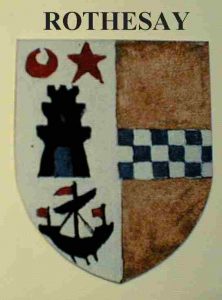Heraldic Origins

The chequered band of three rows of blue and white squares is found in a number of coats-of-arms in Scotland. It represents the Stewart family and has long been a heraldic symbol. It is said that it was first created when highland soldiers wove white ribbons into the black head bands of their bonnets, thus creating the chequered effect.
Military Use

A version of the chequered band was used by a number of Scottish Volunteer Regiments around the 1860’s and the Lovat Scouts wore it at least into the first few years of the 20th. Century.
The Desire to be Different

Around the time of the First World War and shortly thereafter, a number of Scottish Police forces, whose officers wore black peaked caps, sought ways to make their officers easily identifiable from the bus drivers and other local officials, who wore identical caps. These forces began using a removeable white cap covers, and it succeeded, although they became dirty and untidy very easily.
The Sillitoe Tartan

In 1932, shortly after he took office as Chief Constable of Glasgow, Sir Percy Sillitoe arranged for black and white diced cap bands to be tested by the Mounted Branch and by August of that year he deemed the test a success, ordering that all caps should bear the distinctive cap-band.
Since then a number of individuals and forces have claimed to have ‘invented’ the idea, but the small article (below) from the Police Review of 26 August 1932, is the earliest documented mention of the distinctive cap bands known.
The Idea Spreads Across The World

It was not long before all Scottish Police forces were using the diced cap-band and it remained distinctively Scottish until 1974 when the remainder of UK Police forces adopted it.
It is also worthy of note that a number of overseas Police forces such as Australia, St. Helena, Policia Local of Spain, Falkland Islands, Oman and the Chicago Police Department in the USA now use the diced cap band. The ultimate accolade is that the European Union has adopted the black and white chequered design as the universal symbol of the Police in Europe.

